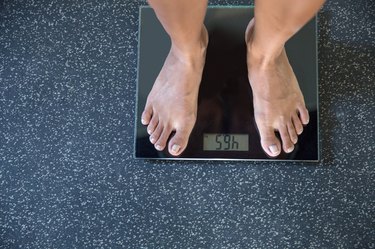
Body mass index is a simple tool that estimates body fatness using a mathematical formula. The only instruments necessary to measure your BMI are a scale, a tape measure -- to determine your height -- and a calculator. If you're unsure exactly how to estimate your BMI, talk to your doctor. Your doctor will most likely calculate your BMI every time you go in for a check-up or a sick visit.
Measuring BMI
Video of the Day
Determining a person's health based on weight and height squared was first developed in the early 19th century, according to a 2006 article about BMI published in the Archives of Disease in Children. But it wasn't until the 1980s that it was used more regularly by healthcare professionals as a means to assess health, and this was only because researchers were finding a correlation between the number calculated and health risk, according to a 2014 article published in Today's Dietitian.
Video of the Day
Your BMI is determined by plugging your weight and height into a mathematical formula:
BMI = weight in pounds / (height in inches x height in inches) x 703.
For example, a 5-foot, 10-inch person weighing 210 pounds has a BMI of 30.1, because (210 / 4900) x 703 = 30.1. A good scale, an accurate height measurement and a calculator are all that's necessary to estimate your BMI, making it easy to measure.
BMI Compared to Other Fat-Measuring Techniques
A number of other techniques are used to measure body fat, including underwater weighing, dual energy X-ray absorptiometry, skinfold measurements and bioelectric impedance. But most of these require a special machine and/or a trained professional for accurate testing. While BMI is not a perfect tool, it's been compared to these other forms of measuring body fat and stands up fairly well on its own.
Dual energy X-ray absorptiometry, or DXA, is considered one of the most accurate ways to measure body fatness and health risk. But because of the expense and complexity, the test is used primarily by those in research facilities.
BMI is a simple, easy-to-calculate tool that can be used anywhere and may be just as good as the more complicated body fat measurements. In fact, BMI measurements compare favorably to DXA measurements, according to a 2005 cohort study published in the International Journal of Obesity. This study compared the use of DXA against BMI, skinfold measurements of body fatness and risk of heart disease in a group of adolescents. The researchers found that both BMI and skinfold measurements correlated well with DXA for assessing health.
What Your BMI Means
Once you know your BMI number, you'll want to know what it means. BMI is divided into weight status categories. Your health risk depends on the category you fall into.
A BMI of 18.5 or less is considered underweight, while a value between 18.5 and 24.9 is considered a normal weight. A BMI between 25 and 29.9 is an indication of overweight, and 30 or greater is a sign of obesity. For good health, you want to fall in the normal weight category. A higher BMI increases your risk of developing a chronic illness such as heart disease, diabetes or cancer. And having a BMI that's too low may pose a different set of health risks.
Another Tool to Measure Health
While BMI is a basic tool used to assess health, it's not the only one. The waist-to-height ratio is an even simpler way to help you determine your risk of disease. Additionally, the waist-to-height ratio may be better at predicting health outcomes than BMI, according to a 2012 review study published in Obesity Review.
To determine your waist-to-height ratio, wrap a tape measure around your waist at your belly button. Do not suck in when taking the measurement. For good health, your waist measurement should be less than half your height. For example, at 5 foot, 10 inches -- or 70 inches tall -- your waist should measure 35 inches or less.
- Centers for Disease Control and Prevention: About Adult BMI
- Cleveland Clinic: Beyond BMI: A Better Tool to Measure Your Health
- Archives of Disease in Childhood: What Use is the BMI?
- Today's Dietitian: Assessing Weight Status -- Is BMI the Best Tool?
- International Journal of Obesity: Comparison of Body Fatness Measurements by BMI and Skinfolds Vs Dual Energy X-Ray Absorptiometry and Their Relation to Cardiovascular Risk Factors in Adolescents
- Obesity Review: Waist-to-Height Ratio Is a Better Screening Tool than Waist Circumference and BMI for Adult Cardiometabolic Risk Factors: Systematic Review and Meta-Analysis